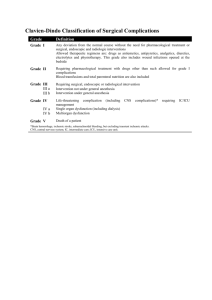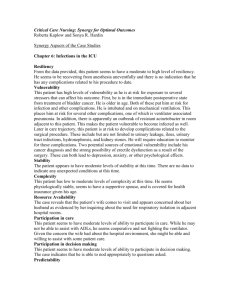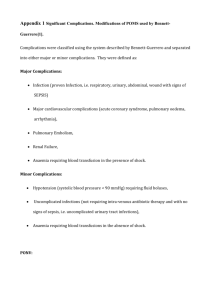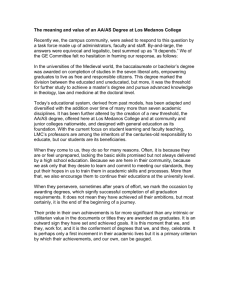Additional file 2: Table S4.
advertisement
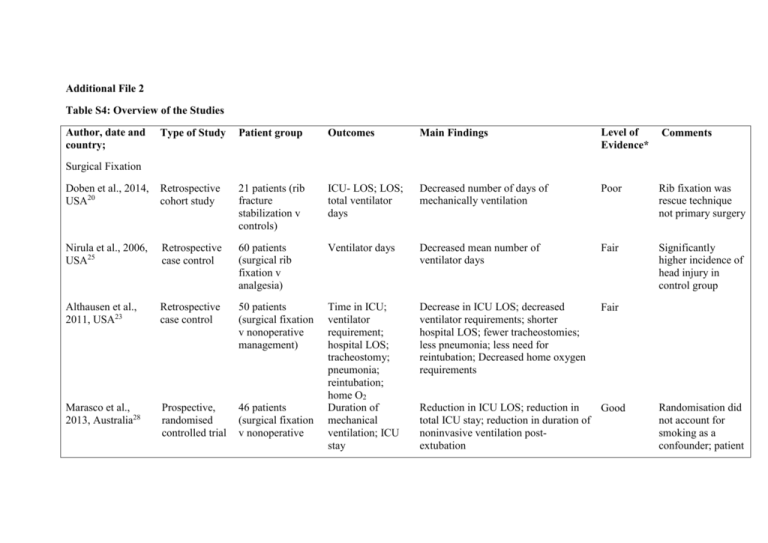
Additional File 2 Table S4: Overview of the Studies Author, date and country; Type of Study Patient group Outcomes Main Findings Level of Evidence* Comments Doben et al., 2014, USA20 Retrospective cohort study 21 patients (rib fracture stabilization v controls) ICU- LOS; LOS; total ventilator days Decreased number of days of mechanically ventilation Poor Rib fixation was rescue technique not primary surgery Nirula et al., 2006, USA25 Retrospective case control 60 patients (surgical rib fixation v analgesia) Ventilator days Decreased mean number of ventilator days Fair Significantly higher incidence of head injury in control group Althausen et al., 2011, USA23 Retrospective case control 50 patients (surgical fixation v nonoperative management) Decrease in ICU LOS; decreased ventilator requirements; shorter hospital LOS; fewer tracheostomies; less pneumonia; less need for reintubation; Decreased home oxygen requirements Fair Marasco et al., 2013, Australia28 Prospective, randomised controlled trial 46 patients (surgical fixation v nonoperative Time in ICU; ventilator requirement; hospital LOS; tracheostomy; pneumonia; reintubation; home O2 Duration of mechanical ventilation; ICU stay Surgical Fixation Reduction in ICU LOS; reduction in Good total ICU stay; reduction in duration of noninvasive ventilation postextubation Randomisation did not account for smoking as a confounder; patient outcomes e.g. pain were not assessed management) Voggenreiter et al., Retrospective, 1998, Germany24 case-control study 42 patients (operative v nonoperative; pulmonary contusion v no pulmonary contusion) Duration of ventilatory support; complications Ventilatory time in surgical patients without pulmonary contusion was significantly shorter than surgical patients with pulmonary contusion and non-surgical patients without pulmonary contusion Fair De Moya et al., 2011, USA58 Retrospective bi-institutional matched casecontrol study 48 patients (surgical fixation v control) Amount of narcotics administered Morphine requirement decreased preoperatively compared to postoperatively; no difference in mean morphine requirements Fair Tanaka et al., 2002, Japan26 Prospective, randomised Study 37 patients (surgical fixation v internal pneumatic stabilization) Ventilatory period; ICU stay; pneumonia Ahmed & Mohyuddin, 1995, United Arab Emirates83 Retrospective, case-control study 64 patients (surgical fixation v mechanical ventilation) Granetzny et al., 2005, Egypt27 Prospective, randomised, comparative 40 patients (surgical fixation v chest wall Duration of assisted ventilation; pulmonary complications Chest wall deformity; pulmonary Shorter ventilatory period; shorter ICU Good LOS; lower incidence of pneumonia; increased forced vital capacity at 1 month; increased percentage of patients that returned to employment at 6 months Lower days of assisted ventilation; Fair lower pulmonary complications infection, septicaemia and barotraumas Decreased duration of mechanical ventilation days; decreased ICU and hospital stay; decreased pulmonary Good No standardisation of doses of NSAIDs and epidurals; no long term follow up No p values of significance Randomisation occurred within blocks of 10 study binding) functions two months postoperatively; pulmonary Complications complications; improved pulmonary function tests patients; conservative group had higher associated injuries Hakim, Latif & Anis, 2012, Egypt84 Randomised, parallel-arm, open label trial 55 patients (lumbar v thoracic epidural) Mechanical ventilation; pneumonia No difference Good No control for pain or respiratory compromise Topcu, Ekici & Sakarya, 2007, Turkey85 Retrospective case series 49 patients (thoracic epidural v PCA) Decreased ICU LOS; decreased pain score from the 6th hour of therapy Fair Greater number of rib fractures in the thoracic epidural analgesia group Truitt et al., 2011, USA29 Prospective, case series 177 patients (intercostal nerve block v control) Pain scores; ICU LOS; mechanical ventilation requirements; pulmonary and cardiac complications. Numeric Pain Score (NPS); respiratory rate; LOS Decreased LOS; improvement in NPS at rest and coughing; decreased respiratory rate Fair Single institution, analgesia was not compared to another therapy Bayouth et al., 2013, USA8 Retrospective chart review 42 patients (IV ibuprofen and narcotics v narcotics) Patient reported pain scores; mean pain requirements Decreased mean daily morphine Fair equivalent over first 7 days of hospitalisation; decreased total weekly morphine equivalent requirement; lower mean highest pain score; lower mean lowest pain score Analgesia No definition of how pulmonary complications were determined including pneumonia Bulger et al., 2004, Prospective, randomised USA36 trial 46 patients (systemic opioid v epidural) Pneumonia; duration of mechanical ventilation; hospital and ICU LOS; mortality Mortality; pulmonary complications 6.0 fold increase in the risk of pneumonia; 2.0 fold increase in ventilator days Good Cross-over allowed between the two groups Gage et al., 2014, USA11 Retrospective cohort study 836 patients (epidural catheters v no epidural) Patients with 3 or more rib fractures had lower mortality at 30, 90 and 365 days; the adjusted odds of death were 0.08, 0.09 and 0.12 respectively; no difference in pulmonary complications; increased ICU LOS Good Large difference in numbers between two cohorts Mohta et al., 2009, India12 Prospective, randomised comparison 30 patients (epidural catheter v paravertebral block) Visual analogue scale (VAS) pain score; pulmonary complications No difference in VAS; no difference in pulmonary complications; increased hypotension in epidural catheter Fair Wisner, 1990, USA35 Retrospective chart review 307 patients (IV narcotics v epidural) Mortality; pulmonary complications Higher mortality rate in IV/IM narcotic group; odds of death were 38% less for patients with epidural pain relief than IV/IM Fair Large difference in sample size between groups Asha, Curtis, Taylor & Kwok, 2013, Australia31 Retrospective, cohort study 227 patients (PCA v interval dosing) Complications; No significant findings hospital LOS; cost Fair Large difference in sample size between groups 11 patients Pain score at rest, Poor Not comparable to Shukla et al., 2008, Retrospective, Improved pain scores after 30 mins at Malaysia40 nonrandomised case series (paravertebral block v initial bolus) on vital capacity and cough compared rest, on vital capacity maneuver and on cough other regional analgesia techniques Ingalls et al., 2010, Randomised, double-blind, USA33 placebo controlled trial 58 patients (lidocaine patch 5% v placebo) No significant findings Good Low dosing of the lidocaine patch Yeh, Kutcher, Knudson & Tang, 2012, USA3 Retrospective review 187 Patients (thoracic epidural v PCA) Longer ICU and hospital LOS; more total ribs fractured; higher incidence of bilateral rib fractures Fair Higher severity of rib fractures in epidural group Wu, Jani, Perkins & Barquist, 1999, USA37 Retrospective study 64 patients (epidural analgesia v PCA) Lower pain ratings at all time intervals with the exception of baseline (0 hour) scores; No difference in LOS Fair Epidural group had more rib fractures Kieninger et al., 2005, USA86 Retrospective chart review 187 Patients (epidural v IV narcotics) Total (IV and oral) narcotic used; non narcotic pain medication; average pain score; pulmonary complications; LOS Pulmonary complications; ICU and Hospital LOS Pain scores; complications: need for intubation, pneumonia, cardiac complications; LOS Hospital LOS; Pulmonary complications Epidural group (with low ISS) had a longer LOS; Higher complications in epidural group (with high ISS) Fair Karmakar et al., 2003, Hong Prospective, non- 15 patients (paravertebral Pain Score; pulmonary Improvements in pain scores after the initial treatment compared to before Poor No control group Kong15 randomised case series block) Function Test treatment Zink et al., 2011, USA39 Retrospective case control study 58 patients (lidocaine v control) Pain scores; narcotic use. Lower pain score at 24 hours after placement; lower pain score at 60 days; no difference in narcotic use Pierre et al., 2005, USA87 Unknown 22 patients: (epidural v PCA) Hospital LOS; pain score Decreased hospital and ICU LOS; lower Poor pain scores at 24 and 36 hours Mackersie et al., 1991, USA30 Prospective randomised trial 32 patients (epidural v IV) Ventilatory function tests; arterial blood gases; visual analog scores Epidural group: improved maximum inspiratory pressure and vital capacity Prospective, randomised trial 24 patients (epidural v PCA) Catecholamine plasma levels; Verbal pain score; maximum inspiratory force and tidal volume Reduced plasma levels of IL-8 on days 2 and 3; reduced verbal rating score of pain on days 1 and 3; improved maximal inspiratory force and tidal volume on day 3 Fair Of 34 patients originally enrolled, 10 dropped out. Prospective, observational cohort study 300 patients (clinical pathway v control) Pain management; ICU and hospital LOS; pneumonia; mortality More PCA prescribed; increased epidural catheter utilisation; decreased shock trauma ICU LOS; decreased hospital LOS; decreased pneumonia; Good Study sample collected over 5 years – changes in practice guidelines during this time not Moon et al., 1999, USA34 Fair Those with more fractures were more likely to receive patches Abstract only Good IV fentanyl: improved vital capacity; changed ABGs - Increase in PaCO2 and decrease in PaO2 Clinical Pathway Todd et al., 2006, USA45 just implementation of clinical pathway decreased mortality Adrales et al., 2002, USA46 Cohort Study 61 patients (pre and post practice guidelines) Duration of Thoracostomy tube; pulmonary complications Post-practice guidelines group: 3 fewer days of thoracostomy tube; less Chest radiographs Fair Limited sample size of pre-practice guidelines group Sesperez et al., 2001, Australia41 Prospective consecutive study 235 patients Variances to elements of care Good Positive variances were not recorded Wilson et al., 2001, Australia42 Prospective consecutive study 146 patients Applicability to pathway Increase in the outcomes achieved between before and after implementation; the elements that incurred the greatest number of variances were assessment, elimination, pain management, and medications Applicability of fractured ribs to a clinical pathway – 93.4% Good Limited discussion on rib fracture pathway procedure Menditto et al., 2012, Italy43 Retrospective, before-after study 240 patients (prepre-Emergency Department observation unit (EDOU) period v post) Mortality or complication; admission to hospital; LOS; ED readmission; cost In Pre-EDOU period: increased LOS; increased rate of hospitalisation 49% v 24%; increased ED readmittance Good Co-morbidities were not evaluated; study in third level hospital Post-EDOU period: increased thoracostomy performed in admitted patients Sahr et al., 2013, USA44 Retrospective, before-after study 148 patients (pre v post protocol) Hospital and ICU LOS Decrease in hospital LOS from preprotocol to post-protocol intervention for patients with 3 or more fractured ribs Good Small group of patients at a single institution Walz, Mollenhoff & Muhr, 1998, Germany48 Prospective study 30 patients (CPAP v no CPAP) Pneumonia; ICU stay No difference in pneumonia; decreased ICU LOS Poor Abstract only in English Bolliger & van Eeden, 1990, South Africa47 Randomised, controlled trial 69 patients (Mechanical ventilation v CPAP) ICU and hospital LOS; pulmonary complications Longer ICU LOS; longer hospital LOS; increased complications 73% v 28% Fair Groups not matched for ISS Fabbrucci et al., 2008, Italy50 Retrospective, consecutive study 81 patients (chest tube v chest tube and VATS) Lower blood transfusion 4 patients with 2-4 units v 15 patient with 2-20units; shorter drainage time 5.7days v 6.3days Poor Descriptive results; Higher ISS in chest tube alone group Smith et al., 2011, USA51 Retrospective review 83 patients (VATS ≤ 5 days after injury v VATS > 5 days after injury) Postoperative complications; indwelling thoracic drainage time; LOS; blood transfusion; mortality Hospital LOS; conversion to thoracotomy Lower rate of conversion to an open procedure; lower overall hospital LOS Fair Ventilation VATS Rib Belt Quick, 1990, USA 52 Prospective, randomised study 20 patients (analgesia v rib belt and analgesia) Pulmonary function; pulmonary complications No difference between groups Poor 107 patients (multimodal v individual therapy) Complications Multimodal therapy was not associated with fewer complications; incentive spirometry reduced morbidity Fair Multimodal therapy; Spirometry Schwed et al., 2013, USA59 Retrospective review Abstract only published Legend: * Level of evidence: Determined using the US preventive services task force recommendations for quality of evidence18. This scoring system was chosen as it appraises evidence from a variety of research designs88. ICU: Intensive care unit; LOS: Length of stay; O2: Oxygen gas; PCA: Patient controlled analgesia; NPS: Numeric pain score; IV: Intravenous; VAS: Visual analogue scale; IM: intramuscular; ISS: Injury severity score; ABG: Arterial Blood gas; PaCO 2: Partial pressure of carbon dioxide; PaO2: Partial pressure of oxygen; EDOU: Emergency department observation unit; ED: Emergency department; CPAP: Continuous positive airway pressure; VATS: Video-assisted thoracoscopy surgery
